Ataccama 15.1.0 Release Notes
|
This release is available in Ataccama Cloud deployments only. |
This page contains the release notes for version 15.1.0 of the Ataccama ONE Gen2 platform. Release information affecting all modules in the platform can be found first, and module-specific information can be found in the corresponding ONE, MDM, RDM, ONE Data, and Data Stories sections. For a full list of bug fixes, see Fixes.
Release Information
Products |
ONE Data Quality & Catalog (including ONE Data and Data Stories), ONE RDM, ONE MDM |
|---|---|
Release date |
2024-01-31 |
Downloads |
|
Security updates |
Known Issues
| This section lists issues we are currently aware of which are considered significant, and which could impact the functionality of your build. We highly recommend reviewing this section before every upgrade. |
| Module | Issue | To be resolved in |
|---|---|---|
RDM |
ONE-53206: RDM enrichment feature does not function. |
15.2.0 |
MDM |
ONE-56889: After the history plugin refactoring, backward compatibility is broken and previously defined plugin settings are ignored. |
15.4.0 |
MDM |
ONE-59667: Occasionally, MDM server fails to start when there is a session in the To resolve this issue, manually delete all sessions in the state |
15.4.0 |
Known Issues Resolved
We report known issues in each release. Below is the list of the issues that have been resolved across the platform for this version.
| Module | Issue |
|---|---|
ONE |
ONE-48932: Very rarely, when trying to view changes in a review request, the published version and changed version both appear blank. |
ONE |
ONE-45718: Trying to delete the draft of a business term after creating a publish request and associated task causes the deletion to fail. Attempts to approve or reject the business term generate errors. |
ONE |
ONE-47632: Very rarely, when deleting a term using the three dots menu, the workflow bar fluctuates between Edited and Deleted states. |
ONE |
ONE-48631: Rarely, after you submit a review request for a term, the workflow bar incorrectly displays View review request instead of the expected Review and publish. |
ONE
Generative AI in ONE
| These are experimental features which are only available in Ataccama Cloud deployments. |
Leverage OpenAI in Ataccama ONE to generate SQL queries and ONE expressions from text prompts, write catalog item descriptions, or provide plain text explanations for existing SQL queries.

All features can be enabled or disabled from Global Settings > OpenAI.

To learn more, see Generative AI in ONE.
Data Transformation Plans
Transform data in ONE using the new data transformation plans. This facilitates two key use cases:
-
Transformation of data quality monitoring project results. In this way, data transformation plans supersede post-processing plans.
-
Standalone data transformation of catalog items.
Once you have configured your data input (catalog item or monitoring project results), you can then add a number of steps, such as filter, split, join, or transform, and add or delete attributes.
Each step represents a data processing job. After transformation, export data to ONE Data or to files in ONE Object Storage, or use it in another plan. You can preview data and validate expressions in real time when working with data transformation plans.

Previously, such transformations had to be executed in ONE Desktop. For more information, see Data Transformation Plans.
Data Remediation Plans
Using data remediation plans, users can load data, metadata, and DQ results from monitoring projects into ONE Data for data remediation.
Data remediation plans are located under Data Quality > Transformation plans and utilize the same plan canvas design as transformation plans, but the predefined data remediation output step writes the term and rules metadata from catalog items to ONE Data: the ONE Data writer step used in transformation plans does not copy information about assigned terms or rules. The remediation step also stores DQ results in ONE Data, meaning you can view DQ results and also filter by DQ results.
The data remediation output is designed for the specific use case of import of issues for manual resolution.
For more information, see Data Remediation Plans.
Monitoring Project Import Improvements
Previously, if you wanted to test new rules on a catalog item in a monitoring project without risking unnecessary changes in a production project, it was necessary to create a separate monitoring project and test the changes there. Now, you can import only the selected catalog items as well as replace them with alternatives.
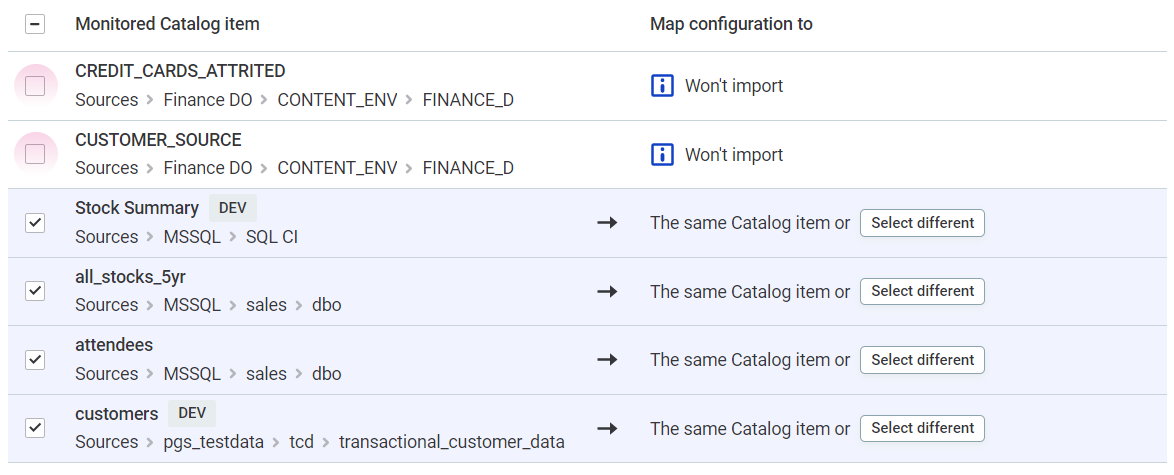
Furthermore, on the attribute level, you can remap attributes (provided the new mapping fulfills data type constraints) or ignore selected attributes in the import.
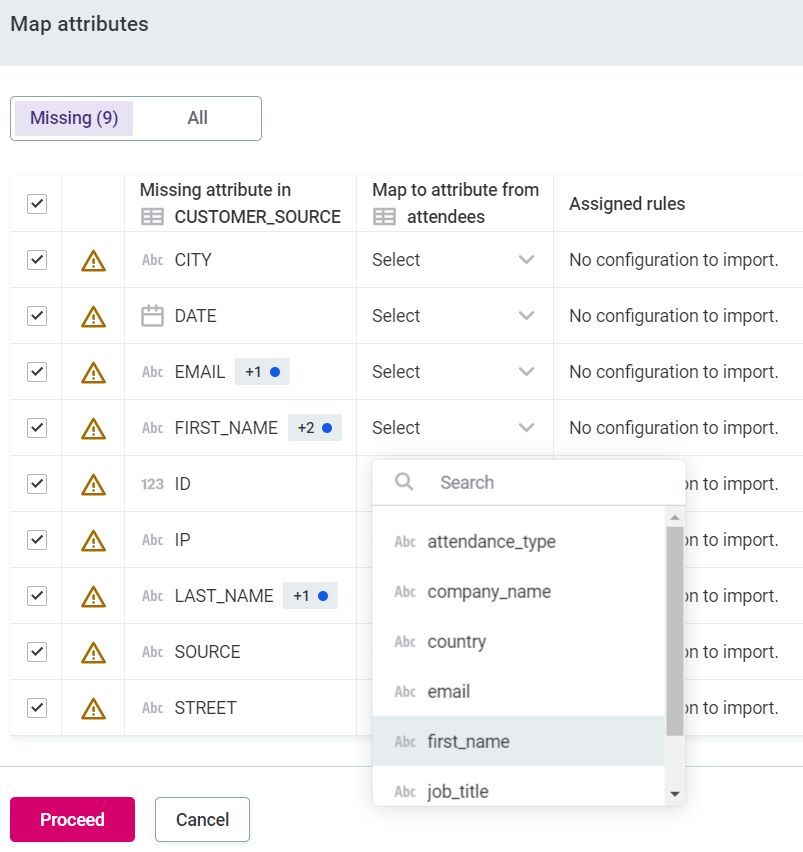
Invalid Data Samples for Catalog Items
For catalog items, you can now see samples of the data that failed the data quality evaluation - invalid data samples. Seeing specific records that failed the DQ rule speeds up the investigation of data quality issues and fixing the data.
To use this feature, first, enable invalid samples on your catalog item, and after running DQ evaluation, straightaway access the invalid sample. See Invalid Samples.
| To use this functionality, storing of invalid samples for catalog items must be enabled on a global level. This can be done only by admin users. For more information, see Retention Settings, section Set retention period on invalid data samples. |
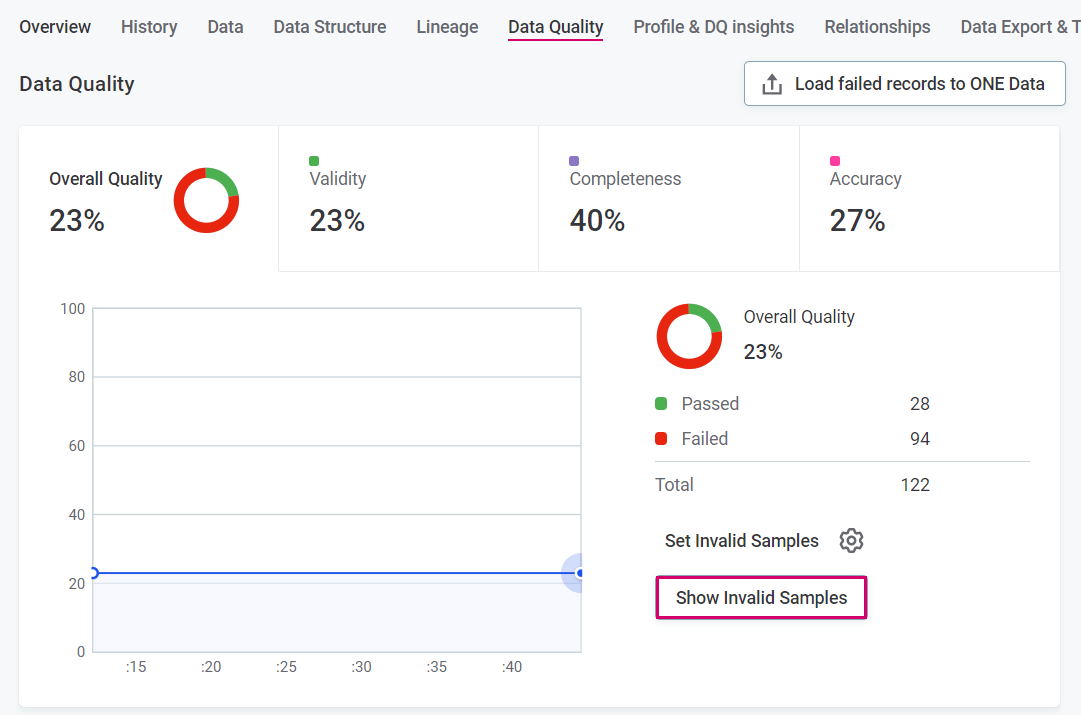

Configurable Global Retention Policy for Catalog Items and Monitoring Projects Results
In ONE, you can now configure a global retention policy for the results of monitoring projects and results of data quality evaluation on catalog items.
You can separately set retention for the following:
-
Results of monitoring projects (previously configurable only via API).
-
Results of data quality evaluation on catalog items.
-
Invalid samples for catalog items, that is, the samples of records that have failed the data quality evaluation on the catalog item.
Retention period can be based on days or runs—results older than the defined number of days or runs are deleted.
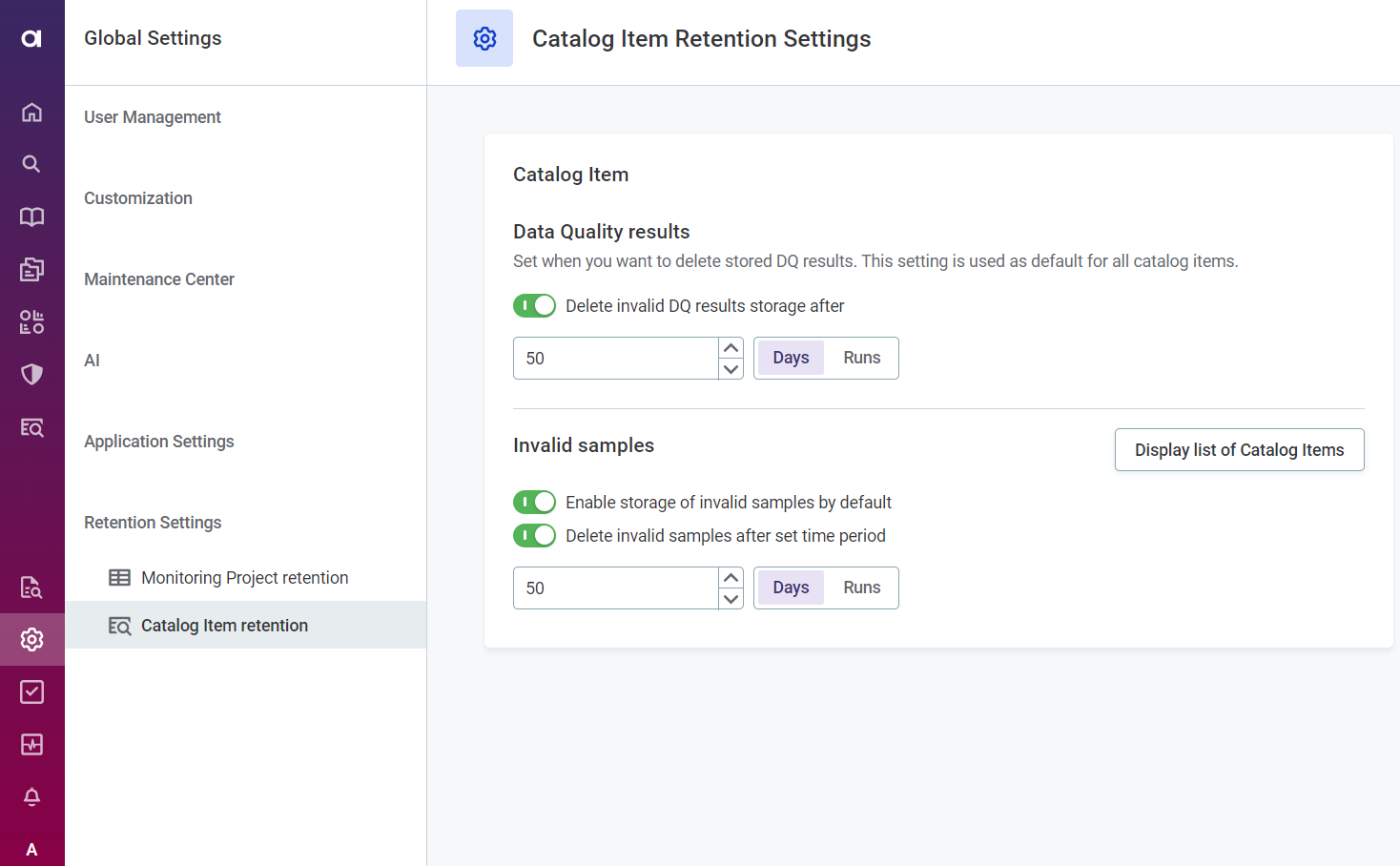
Custom File Import
Data engineers need to be able to configure file import settings in an object or file storage connection so that all CSV and Microsoft Excel files imported and processed properly. Custom file import allows for customization of CSV and Microsoft Excel file import settings for individual files, folders or whole connections.
Previously, the platform attempted to detect the file parsing options and header rows, but it was necessary to override the detected parameters in some cases. The previously available autodetection without any customizability prevented the import of such files.
For more information, see Custom File Import.

Support for Power BI Report Server
In addition to the cloud-based Power BI solution, you can now also connect to the on-premise Power BI Report Server. A new connector has been added for this purpose.
For more information, see Power BI Report Server Connection.
Support for Tableau Server
In addition to Tableau Cloud, you can now connect to Tableau Server. For details, see Tableau Connection.
Term Suggestions Overview
We have streamlined how term suggestions are presented in ONE. You can now see, approve, and reject them from a single location.
To do this, go to Knowledge Catalog > Term Suggestions.
| Select a term suggestion to view more details before making your decision. |
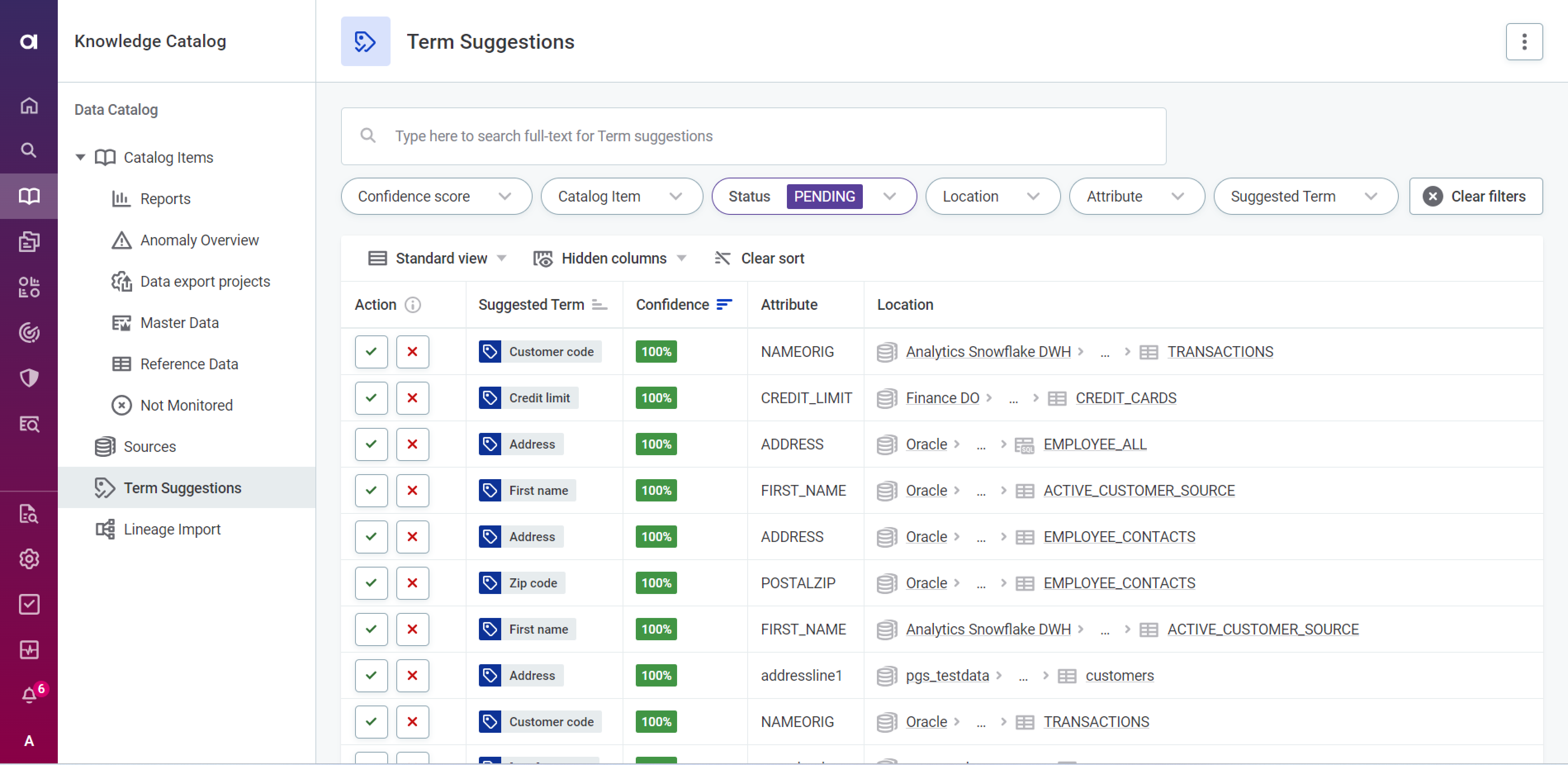
Read File Variables Task Extended and Write File Variables Added
The Read File Variables task in ONE Desktop was extended to support not only property files as inputs but also text files (lines or whole file).
There is also a new task, Write File Variables, to write values (typically contents of variables) into property or text files.
Improvements to Workflows and Tasks
This version brings in multiple improvements and changes in workflows and tasks:
-
It is now possible to assign tasks to roles, in addition to users and groups.
-
The support for user assignees was replaced by assigning to a group with the possibility of specifying the user.
-
To prevent the creation of tasks without an assignee who could resolve them, the tasks must now always be assigned to a group. This is achieved in two ways.
First, when configuring workflows, it is now required to specify a fallback (backup) group that can manage the task if the assigned approver is not available. Additionally, only users with the
MMM_adminidentity provider role or users belonging to the fallback group can reassign the tasks. -
Reviewing changes is now easier as the task cards include direct links to assets associated with the task.
-
To simplify task management, when you make changes to a subtask, you are now automatically set as the assignee. Furthermore, the task status changes to In progress once one of its subtasks is approved.
ONE Data
Overwrite Existing Tables
When loading data to ONE Data from another catalog item in ONE, you can now overwrite an existing table instead of creating a new one. To do this, select Overwrite existing ONE Data table and choose the table you want to replace.

| Keep in mind this deletes all existing data from the selected table. For more detailed instructions about importing data to ONE Data, see Import Data from a Catalog Item. |
Stewardship in ONE Data Tables
Manage access to ONE Data tables through stewardship, the primary solution for handling data asset ownership in ONE.
We recommend assigning ownership of your tables when creating a new ONE Data table to prevent any unauthorized access. If it is not set on the table level, the stewardship configuration is inherited from the data source.
If you are creating a table from scratch instead of loading an existing catalog item or importing a file, change the stewardship from the table Overview tab.
Allow Loading to ONE Data
All data sources can have data loading to ONE Data turned on or off as required. On a source connection, use Enable exporting and loading of Data.
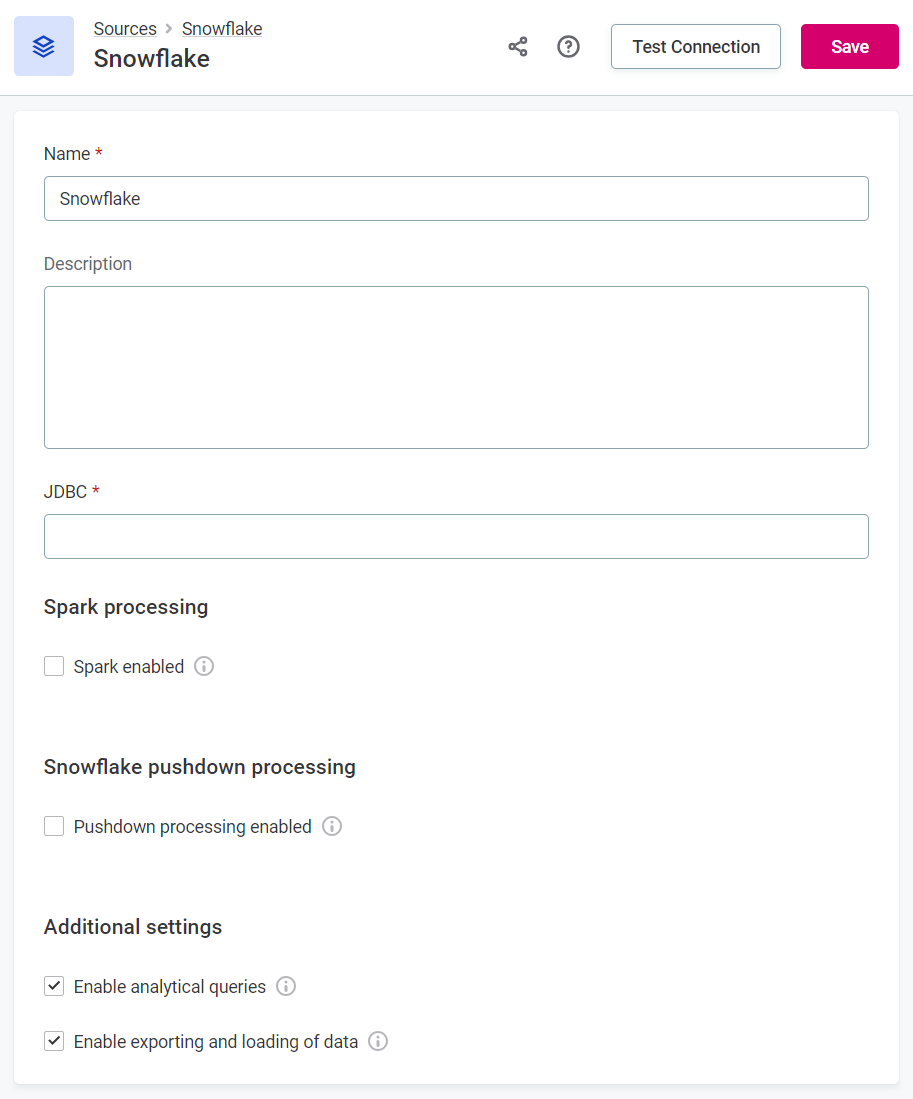
Load to ONE Data
Load to ONE Data is now a standalone action, independent of Export. Use the three dots menu and select Load to ONE Data.
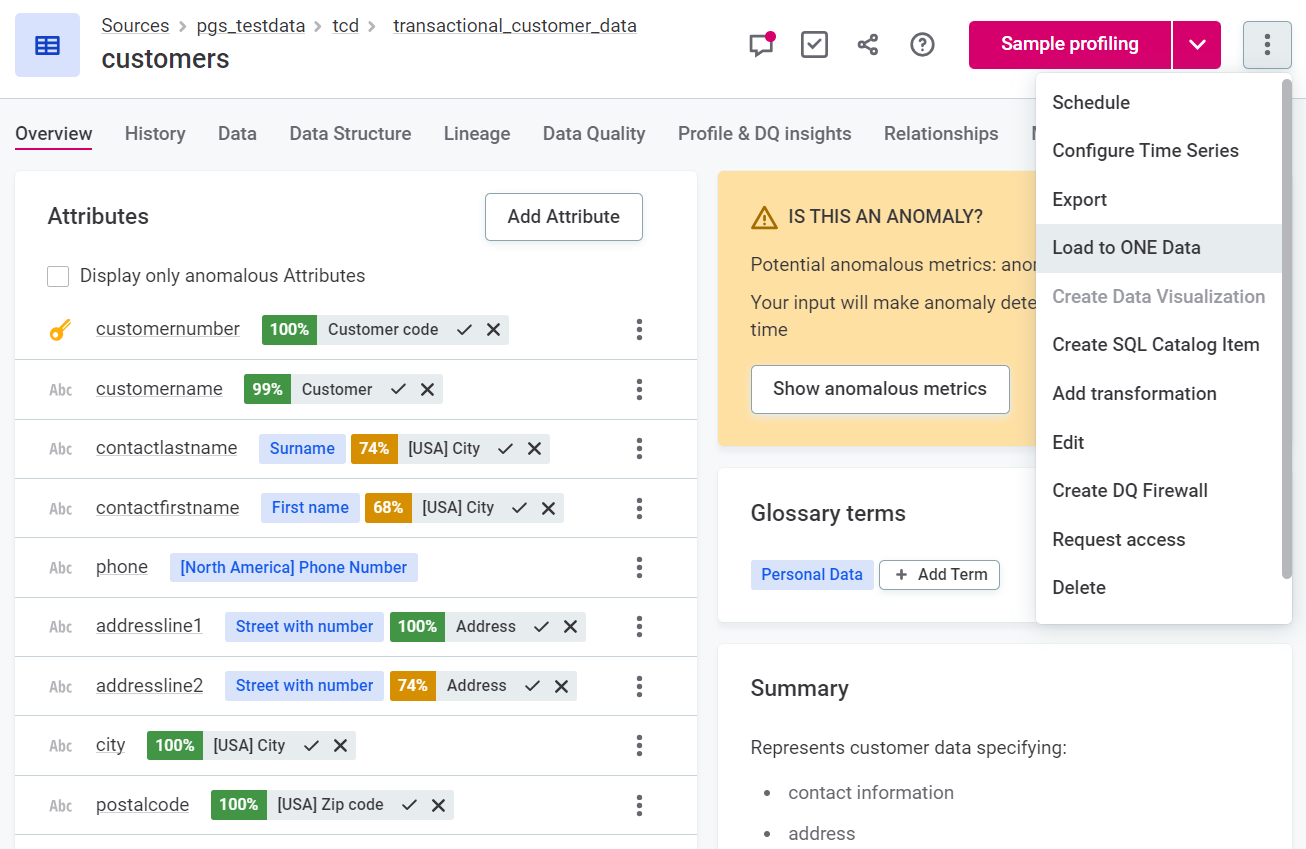
There is also a shortcut to load only failed records from the Data Catalog to ONE Data:
-
On the catalog item Overview tab, locate the Data Quality widget. Use the three dots menu, and select Load failed records to ONE Data.
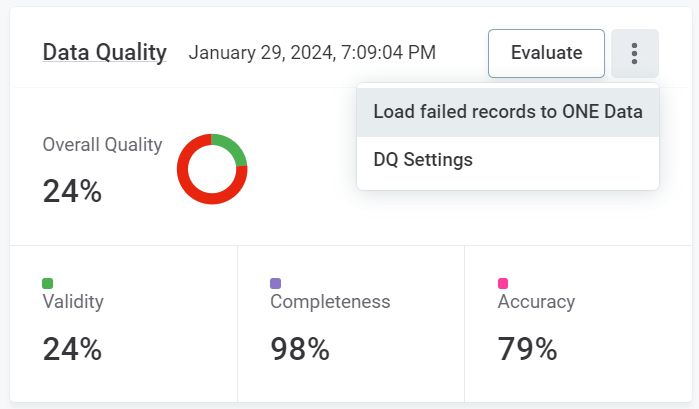
-
On the catalog item Data Quality tab, select Load failed records to ONE Data.
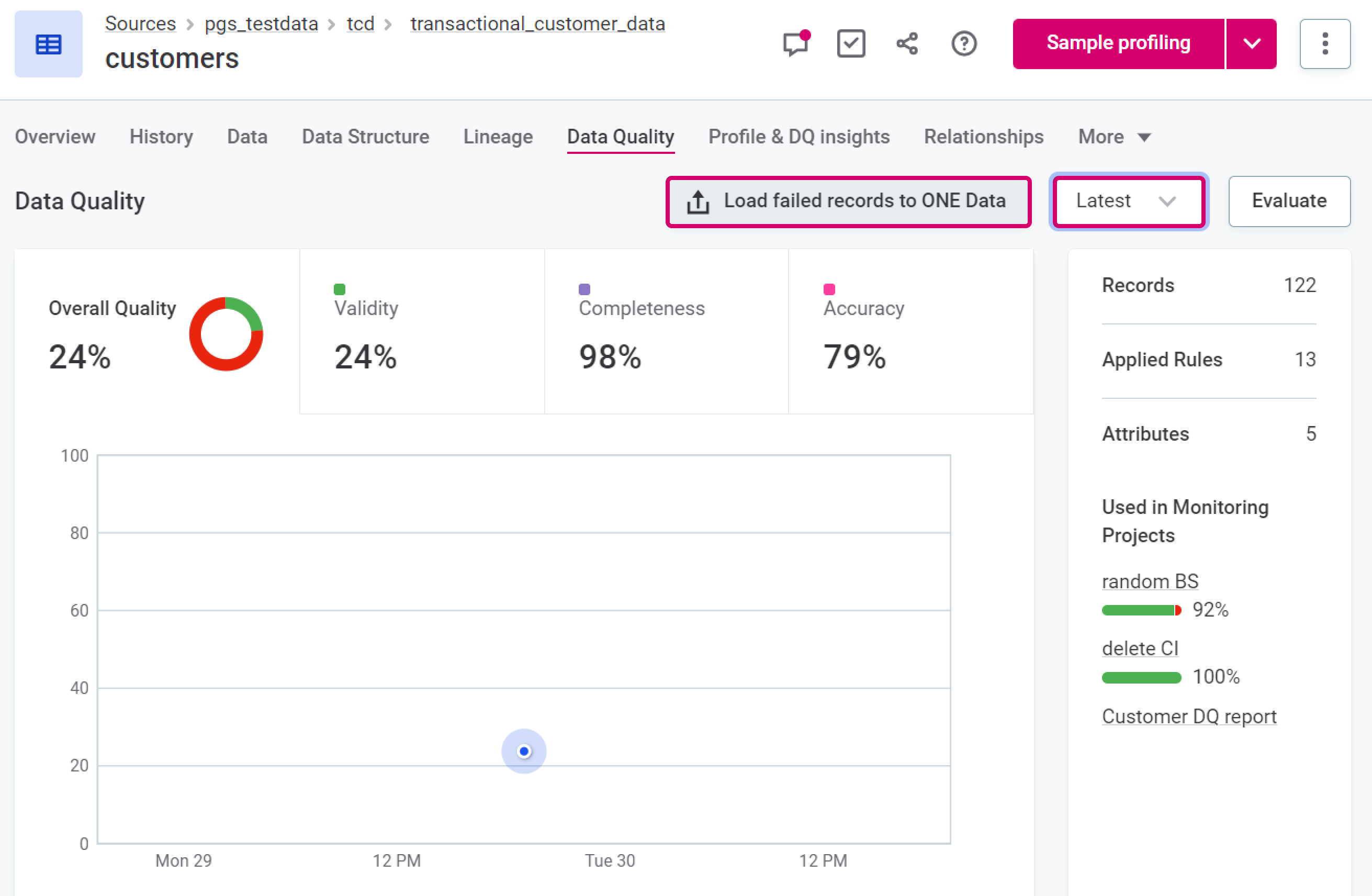
This option is only available when you are viewing the Latest results.
UX Improvements
To make working with ONE Data even easier, we have introduced the following:
-
You can now fill in multiple cells at once. To do this, when pasting, select an array of cells (spanning one or several columns) instead of a single one.
-
If you select Any or All attributes when filtering records, the filter automatically finds records that failed all DQ rules until you change the filter settings.
-
If you are importing catalog items with component or aggregation rules applied, these rules are not imported to ONE Data and cannot be used in filters. You can see whether the catalog item has any such rules applied during the import process.
-
When a record fails DQ evaluation, the tooltip on the record now includes an explanation about why it failed.

Data Stories
These are the key updates introduced in the latest version of Data Stories:
-
We have improved the Cumulative Sum function, ensuring it seamlessly integrates with Multiseries charts. When using this feature in the visualization builder, you no longer encounter validation errors.
-
The name of the source catalog item or Data Quality (DQ) result is now prominently displayed right above the raw data in the table in Data View. This gives you a clearer reference to your data source.
-
We’ve renamed the Top N feature to Top/Bottom Values and refreshed the UI. An added tooltip briefly explains how it affects your visualization results.
-
You can now effortlessly copy visualizations across different collections. Select Copy from the three dots menu next to the visualization, then choose the target collection.
-
Visualization names are now displayed directly in the pop-up editor when editing a visualization from the Report Builder, whether it’s a dashboard or story. Thanks to this, the editing process is smoother and you don’t need to navigate away from the task at hand.
-
In both the Story and Dashboard editors, the side panel containing Collections and Visualizations is now resizable. This allows you to adjust the panel size to suit your workflow and needs.
-
We’ve updated the navigation bar in the Visualization Builder for a sleeker design. The Home tab is now distinctly separated from other visualization tabs.
-
Using the Create option on Reports and Home pages you can now create only Dashboards or Stories but not Visualizations.
-
You can now enhance your Line Charts (both Single and Multiseries) with the new Show boundary gap setting. This feature positions axis labels in the center of the band delimited by two axis ticks, offering a clearer way to present your data.
-
Both KPI and Gauge Charts now feature segmentation capabilities. Enabling Show segments divides the progress bar into distinct segments, aiding in tracking progress towards multiple milestones. Customize these segments with different colors and completion rates, and easily add new segments (Add segment option).
-
Data Stories is now more accessible with added localization support for Czech, German, French, and Italian language.
-
The color picker has been improved to offer a richer selection of colors in the default scheme. You can now easily assign custom colors to each dimension value.
Hover over and select the three dots menu next to a value to reveal the available options, including Standard colors, Ataccama colors, and a Custom color selection tool.
MDM
Database Performance Optimization
We have introduced two features that help improve the database performance of PostgreSQL databases from the MDM Web App Admin Center.
Database Monitoring
You can now download a ZIP file containing essential database information, for example, database monitoring logs, Hikari configuration, or DDL script. It serves as a tool for debugging and addressing performance issues. Additionally, you can temporarily (until the next server reboot) change the following logging settings:
-
Show SQL request parameters.
-
Set a minimum duration of a logged SQL request. You can access the functionality from the Database tab in the MDM Web App Admin Center. To learn more, see MDM Web App Admin Center, section Database.
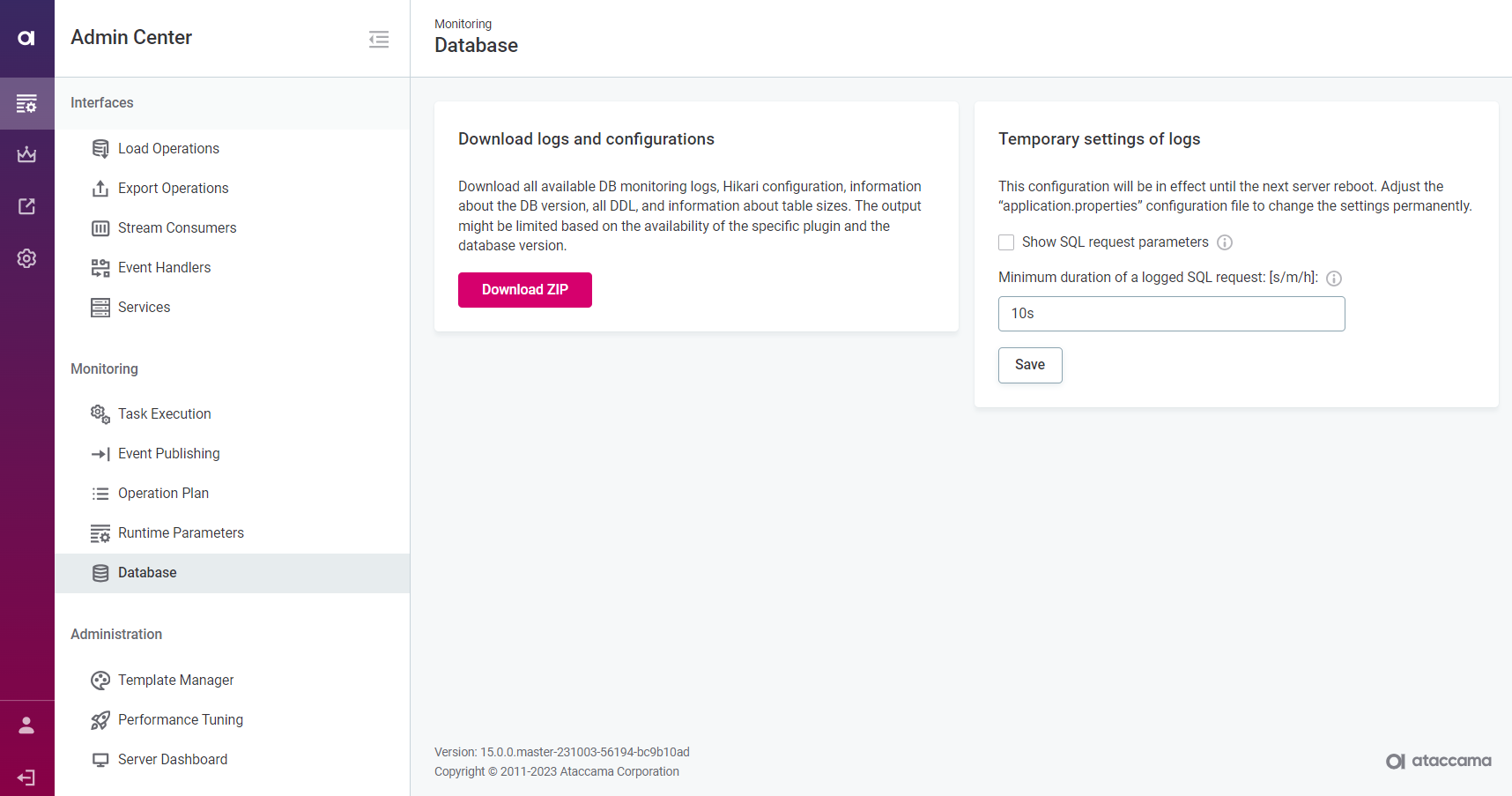
Performance Tuning
You can now download and upload performance settings and retrieve performance statistics to optimize and monitor SQL query performance. You can access this from the Performance Tuning tab in the MDM Web App Admin Center.
To learn more, see MDM Web App Admin Center, section Performance Tuning.
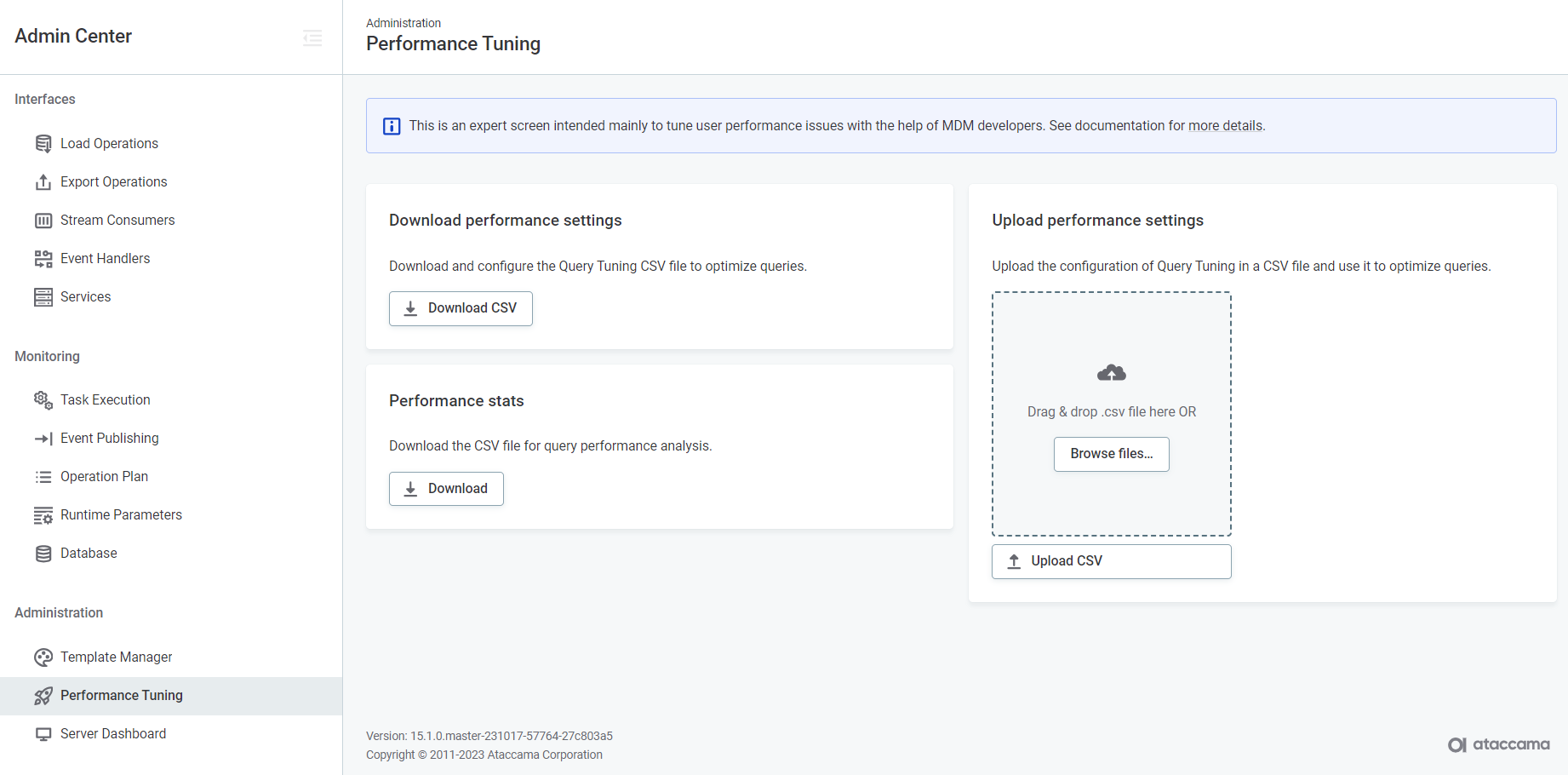
Git Operations
It is now possible to deploy a new configuration from the MDM Web App Admin Center. You can view current configuration and the latest commits, fetch recent changes from the Git repository, apply one of the newer commits, and clone the config repository.
To learn more, see MDM Web App Admin Center, section Server Dashboard.
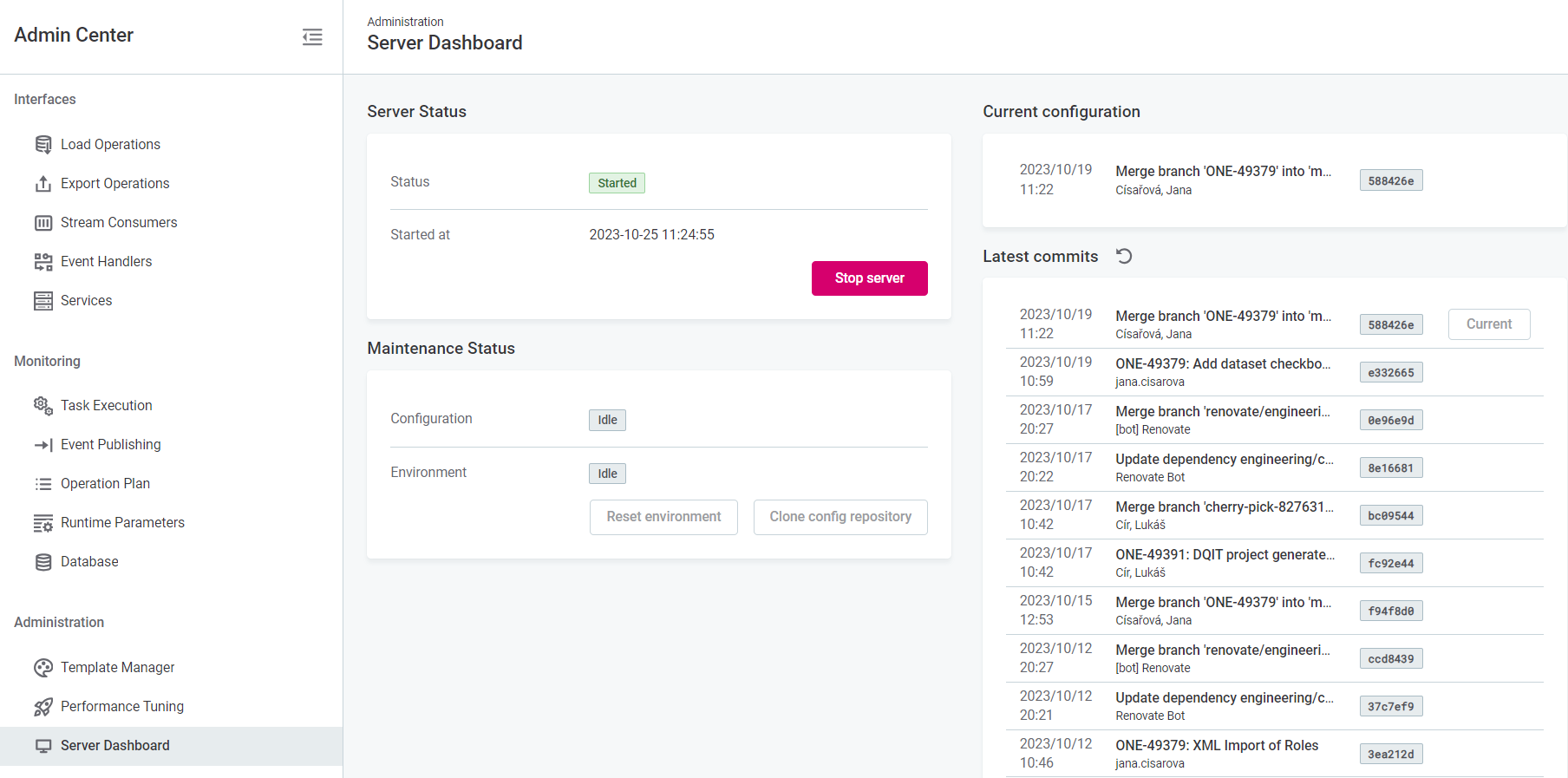
RDM
Changes to Import and Export Dialogs
We have refreshed the Import and Export dialogs in RDM Web App:
-
If you are using custom separators, line endings, or a datetime format, choose Custom. Previously, this option was called Not in list.
-
Date and time can now be specified using a slash (
/) as the separator. -
We have updated the list of supported date and time formats. For more information, see Importing and Exporting Data in RDM, section Import Requirements.
Fixes
ONE
Click here to expand
-
ONE-50052: To enhance the clarity of terminology in ONE UI, "DQ check", "Check", and "Rule instance" are not used anymore and have been replaced by the word "Rule". "Assign" rule to attribute has been replaced by "Add" or "Apply".
-
ONE-51745: Changed the checkbox label (and appropriate tooltip) on connection creation/edit screen from “Allow data export” to "Enable exporting and loading of data".
-
ONE-50303: Monitoring project item page no longer crashes if user does not have access to rule.
-
ONE-49504, ONE-49010: Requests on DQF larger than 1MB no longer failing.
-
ONE-50190: You can now delete values from lists in DQ rule implementation.
-
ONE-50004: Rule attributes mapping works as expected even when you exceed 10 attributes.
-
ONE-49543: Monitoring project results retention policy now functions correctly for custom export which do not produce standard export file link.
-
ONE-49404: Paths to catalog items are empty on DQ tab of the term.
-
[Feature] ONE-49269: Improved visibility of Edit action in data reconciliation.
-
ONE-49033: Freshness can’t be enabled on sources that don’t support it.
-
ONE-48635: Error message no longer displaying after updating outdated rules in monitoring projects after changing rule dimension.
-
ONE-48489: Attribute DQ results are always visible when you switch between runs in monitoring projects.
-
ONE-48450: Notification recipient selector working when you filter for names.
-
ONE-48404: Project DQ results fetching is now batched.
-
ONE-48048: Rule type names fixed when creating a rule from profiling information.
-
ONE-48044: Layout fixed in right sidebar DQ widget.
-
ONE-47463: It’s no longer possible to create aggregation rules on catalog items with pushdown enabled to avoid issues with processing.
-
ONE-44624: Last Run date correctly updated in monitoring project.
-
ONE-47134: Edge-case duplicate scrollbar issues fixed in monitoring project.
-
ONE-52809: Issue with slow listing of Business Terms fixed.
-
ONE-52633: In reconciliation projects, fixed the issue with the Continue option being disabled after adding a source or target.
-
ONE-52522: After using search in a monitoring project, catalog items to monitor do not disappear from the screen anymore.
-
ONE-51980: When a term is added to multiple DQ evaluation rules, the validity percentage is now displayed for all rules after running DQ evaluation.
-
ONE-51807: You are now warned when attempting to run a plan with invalid configuration.
-
ONE-51757: Post-processing plan output keeps the order of rule attributes.
-
ONE-51707: Fixed the issue where after deleting a DQ dimension, user was not redirected to the DQ dimensions settings screen.
-
ONE-51461: DQ firewall debug screen now loads as expected when visited directly via URL.
-
ONE-51412: Fixed issues with Create section in monitoring projects Reports.
-
ONE-51399: Fixed issue where
SchemaCheckjob on connection without default credentials fails. -
ONE-51354: Groups cannot be tagged in comments anymore, so users are not misled to the assumption that group mentions in comments should work.
-
ONE-51281: You no longer have an option to remove tag from "Import monitoring project configuration" source selection.
-
ONE-51220: Fixed issue where after upgrade from 13.9.4 to 14.5.1, notifications were not sent for existing monitoring projects.
-
ONE-51215: Fixed issue in DQ firewall debug where rule instance results did not refresh.
-
ONE-51097: Listing of attributes on the project item detail page now has a toolbar with an option to hide columns.
-
ONE-50895: Fixed issue with incorrect e-mail templates.
-
ONE-50844: Fixed issue with
HTTP TRACE/TRACKmethod enabled in DQ firewalls. -
[Improvement] ONE-50816: DQ evaluation operations in Catalog that do not generate invalid samples are now faster as they fetch only required attributes.
-
ONE-50812:
GetObservabilityIssuesis not slow on large data anymore. -
ONE-50767: Fixed issue where catalog item DQ historic configuration could be changed.
-
ONE-50766: Fixed issue where catalog item DQ was showing current configuration instead of historic one.
-
ONE-50638: Documentation link from Slack integration settings now points to the correct page.
-
ONE-50615: Improved GraphQL response on performance data for
SourceObservabilityOverview/ConnectionObservabilityOverview. -
ONE-50611: Fixed issue where
MMM-14.2.0-2023-01-18-monitoring-project-notifications-migration.sqlgenerated invalid notification configuration. -
ONE-50601: Fixed issue where monitoring project import generated null attribute reference in anomaly detection check attribute when original monitoring project referred to a deleted version of the attribute.
-
ONE-50525: In the Add rule dialog, switching from All Rules to Suggestions tab before loading all rules now does not break the Suggestion tab.
-
ONE-50513: Catalog item DQ evaluation - switching to historic processing now works as expected.
-
ONE-50413: Fixed UI issue with overflowing values on the Outlier Detection screen.
-
ONE-50348: Fixed issue with term DQ evaluation failing after upgrade to 15.0.0.
-
ONE-50303: Monitoring project item page does not crash anymore when a user does not have access to a rule.
-
ONE-50297: Fixed issue with loading data to ONE Data failing if no rules were applied.
-
ONE-50126: Fixed layout error when displaying deleted catalog item with deleted source.
-
ONE-50043: Fixed duplicate freshness check times in anomaly detection.
-
ONE-49770: After renaming columns in a database, you now don’t have to recreate the column configuration in monitoring projects.
-
ONE-49716: Fixed issue where DQ rules on monitoring projects disappear after new attributes in VCI are added or removed.
-
ONE-49440: Fixed issue where Data observability Systems overview screen showed no data for non-admin users.
-
ONE-49397: Fixed issue where publishing DQ firewall entity from monitoring project failed.
-
ONE-49105: Fixed UI issue with an overflow for long mask when creating rule from profiling mask results.
-
ONE-48457: Removed the excessive empty space displayed on the rule Implementation tab on smaller screens.
-
ONE-48319: Datetime values are now fully displayed on the DQ firewall Debug tab.
-
ONE-44515: After creating MS Teams notifications in monitoring projects, they are now correctly displayed as enabled in the notifications table view.
-
ONE-50291: In reconciliation projects, the Show more option on the source and target Mapping screen is now working.
-
ONE-50226: Fixed issue where in the name filter in the Add rule dialog, results stopped refreshing when the user changed the name to filter multiple times.
-
ONE-50223: Rules without access are now displayed as expected on the catalog item Data Quality tab.
ONE Data
Click here to expand
-
ONE-47886: Fixed the issue with sample and full profiling failing.
-
ONE-45512: On-the-fly validation works for multi-attribute rules.
-
ONE-47588: After deleting a table, you can now create a new one with the same name.
-
ONE-44486: Fixed the issue with importing invalid records in case component and aggregation rules are applied to the original catalog item.
-
ONE-48168: Creating a new ONE Data table when importing invalid records from an existing catalog item no longer fails if there are no invalid records found.
-
ONE-45445: Jobs for building lookup items no longer get stuck in the Processing Center if the screen is reloaded during the action.
-
ONE-50485: After adding a record with empty cells, an error is no longer thrown when switching from the Data tab.
Data Stories
Click here to expand
-
ONE-47837: When using a multiseries chart (such as a bar chart) with the Top N function disabled, the Number of values to show feature now works as expected.
-
ONE-47985: Fixed the issue with navigation between slides in story presenter mode when using slide titles in the right-side navigation bar.
-
ONE-47547: In certain visualization configurations on the Visualization Builder page, the last label on a chart is now fully visible.
-
ONE-47565: When a KPI displays a metric as a percentage, the target value is automatically converted to a percentage as well.
MDM
Click here to expand
-
ONE-40532: Special characters in the entity detail tab label are now displayed correctly in the MDM Web App.
-
ONE-50170: Longer field labels are now displayed correctly in the MDM Web App.
-
ONE-46795: Attempting to activate and deactivate authored records from related templated records no longer results in the application freezing.
-
ONE-45375: OR filter condition now works as expected.
-
ONE-49586: Matching proposals search using advanced filter now works as expected.
-
ONE-48400: Autocorrects now work correctly when no enrichments are defined for this entity.
-
ONE-47462: Custom labels are displayed correctly for virtual master entities.
-
ONE-47712: AI Matching custom permissions now work as expected.
-
ONE-22150: Template actions permissions now work as expected.
-
ONE-46658: Matching proposal resolution tab issues were fixed.
-
ONE-47150: Resolve and publish dialog opened from the task bar now shows a correct message.
-
ONE-45147: The copyColumns child→parent operations now work as expected.
-
ONE-49814: Relationship metadata is generated correctly if the relationship name contains upper case letters.
-
ONE-44909: The Apply button works correctly after discarding the search filter in the record listing.
-
ONE-46502: The automatic task configuration search issue was fixed.
-
ONE-44696: Same system relationships between virtual instance tables are now recognized correctly.
-
ONE-49972: Output interfaces with conditions now work as expected.
-
ONE-48931: Entities with linked reference data sets on the master layer are now listed correctly when configuring custom permissions.
RDM
Click here to expand
-
[Feature] ONE-46237: Added the property
ataccama.one.rdm.features.environment.reset.enabled.If set to
true, the Reset RDM option is available in RDM Admin Console. This allows users with an admin role to control how the environment is reset and is particularly useful for Ataccama Cloud non-production environments.For more information, see RDM Application Properties^.
-
ONE-52460: The REST API Swagger UI is now available at:
rdm.<domain>/swagger-ui/index.html. -
ONE-46508: Added locale-based date and datetime patterns to the Export dialog.
-
ONE-46631: Fixed the issue with RDM Web App freezing due to ongoing user synchronization in Keycloak.
-
ONE-49321: Fixed the issue with RDM Web App occasionally getting stuck while processing configuration changes.
-
ONE-47617: Improved publishing when working with some versions of Oracle databases.
Was this page useful?
